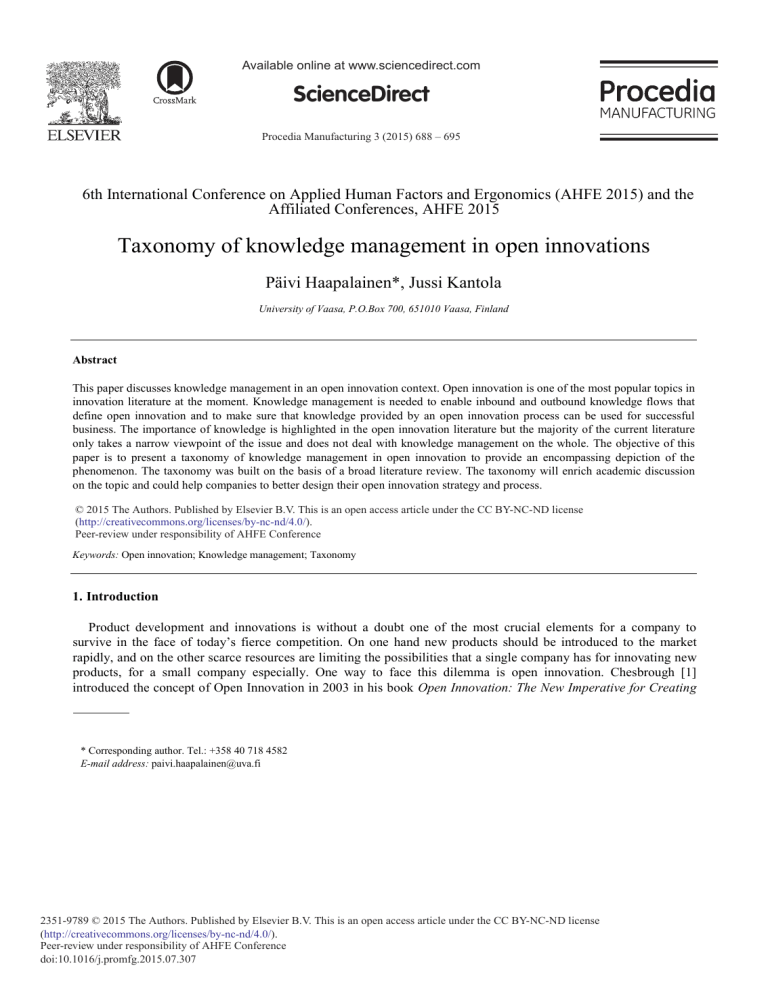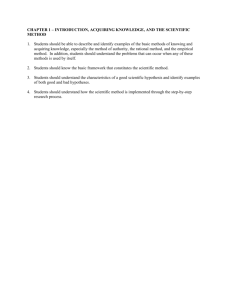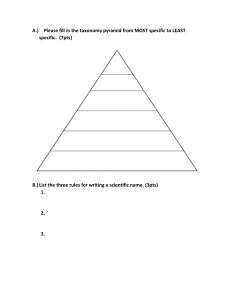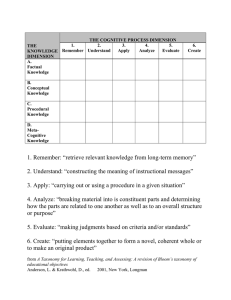
Available online at www.sciencedirect.com ScienceDirect Procedia Manufacturing 3 (2015) 688 – 695 6th International Conference on Applied Human Factors and Ergonomics (AHFE 2015) and the Affiliated Conferences, AHFE 2015 Taxonomy of knowledge management in open innovations Päivi Haapalainen*, Jussi Kantola University of Vaasa, P.O.Box 700, 651010 Vaasa, Finland Abstract This paper discusses knowledge management in an open innovation context. Open innovation is one of the most popular topics in innovation literature at the moment. Knowledge management is needed to enable inbound and outbound knowledge flows that define open innovation and to make sure that knowledge provided by an open innovation process can be used for successful business. The importance of knowledge is highlighted in the open innovation literature but the majority of the current literature only takes a narrow viewpoint of the issue and does not deal with knowledge management on the whole. The objective of this paper is to present a taxonomy of knowledge management in open innovation to provide an encompassing depiction of the phenomenon. The taxonomy was built on the basis of a broad literature review. The taxonomy will enrich academic discussion on the topic and could help companies to better design their open innovation strategy and process. © 2015 2015 The The Authors. B.V. This is an open access article under the CC BY-NC-ND license © Authors.Published PublishedbybyElsevier Elsevier B.V. (http://creativecommons.org/licenses/by-nc-nd/4.0/). Peer-review under responsibility of AHFE Conference. Peer-review under responsibility of AHFE Conference Keywords: Open innovation; Knowledge management; Taxonomy 1. Introduction Product development and innovations is without a doubt one of the most crucial elements for a company to survive in the face of today’s fierce competition. On one hand new products should be introduced to the market rapidly, and on the other scarce resources are limiting the possibilities that a single company has for innovating new products, for a small company especially. One way to face this dilemma is open innovation. Chesbrough [1] introduced the concept of Open Innovation in 2003 in his book Open Innovation: The New Imperative for Creating * Corresponding author. Tel.: +358 40 718 4582 E-mail address: paivi.haapalainen@uva.fi 2351-9789 © 2015 The Authors. Published by Elsevier B.V. This is an open access article under the CC BY-NC-ND license (http://creativecommons.org/licenses/by-nc-nd/4.0/). Peer-review under responsibility of AHFE Conference doi:10.1016/j.promfg.2015.07.307 Päivi Haapalainen and Jussi Kantola / Procedia Manufacturing 3 (2015) 688 – 695 689 and Profiting from Technology. Open innovation refers to external knowledge flowing into the company (inbound open innovation) and internal knowledge flowing out from the company (outbound open innovation) that the company can use when innovating new products and when introducing their own innovations to market [1, 2]. By the definition of open innovation knowledge lies in the heart of it [1–4]. Thus, knowledge management is a fundamental part of managing open innovations. Various writers state that information and knowledge flows between different parties are the key elements in open innovation [e.g., 5–8]. However, they do not further explain how to manage this knowledge and these flows, or look at this issue only from a certain point of view. There still seems to be a lack of more holistic view to the debate on knowledge management in an open innovation context. The objective of this paper is to introduce a taxonomy of knowledge management in open innovation. The purpose of taxonomy is to classify and label items into categories that share common characteristics [9]. Thus it builds a holistic view to the phenomenon, but in a way that reduces its complexity and makes the real life incident easier to comprehend. The rest of this paper is organized as follows: after a brief literature review in Section 2, the empirical study method is reported in Section 3. The results are then presented and discussed in Section 4, with the final conclusion in Section 5. 2. Theoretical background Huizingh [10] provides an interesting review about open innovation literature. He states that open innovation “comes in many forms and tastes, which adds to the richness of the concept but hinders theory development”. Openness of innovation, financial issues of knowledge transfer, different knowledge processes, inbound and outbound knowledge flows as well as the effectiveness of the open innovation process are discussed in the review. Huizingh [10] further presents that open innovation consists of two parts: first, is the way from closed to open innovation, and second are various open innovation practices. Dahlander et al. [11] also provide a broad literature review while they explore the openness of innovation. They conclude that internal capabilities and external relations are complementing rather than substituting each other. Based on inbound and outbound knowledge flows and the pecuniary/non-pecuniary nature of innovation they introduce four categories of openness: 1) acquiring, 2) sourcing, 3) selling, and 4) revealing. Acquiring and sourcing are related to inbound open innovation, and the former requires processes like licensing or buying, while the latter is more about “taking and using”. In the case of outbound open innovation a company can sometimes sell knowledge to others, but in other cases may simply reveal it to others. [11] Wallin et al. [3] introduced a process model for integrating knowledge in open innovation. This model consists of five states: defining the innovation process steps, identifying relevant innovation knowledge, choosing an appropriate integration mechanism, creating effective governance mechanisms, and balancing incentives and controls. Each of these states is described thoroughly in the paper. [3] Hurmelinna et al. [12] bring another important issue into the discussion of open innovation: protecting knowledge and thus innovation. The appropriability regime depends on the nature of knowledge (explicit or tacit) and the efficacy of legal protection. The tacit nature of knowledge as such provides fairly good protection as such and if there is also strong legal protection (patents, copyrights etc.) then the appropriability regime is very strong. If the nature of knowledge is explicit then good legal protection is needed; otherwise, it is easy for others to use that knowledge. [12] Another interesting view to open innovation are open innovation strategies. Simeth et al. [13] explore what makes companies use an open science strategy, which means adopting academic principles for sharing knowledge. They conclude that companies that need scientific knowledge themselves are also more willing to share it with others. Kyläheiko et al. [14] research technology strategies in different knowledge regimes, stating that the choice of a strategy depends on the appropriability regime, technological opportunities faced by the company, and the degree of cumulativeness and complexity of technological knowledge in the industry. Companies can choose an offensive or aggressive strategy, an opportunistic or specialized technology strategy, a defensive or dependent strategy or an imitative strategy. [14] Different technology strategies require different methods of using both inbound and outbound open innovation. Schuhmacher et al. [15] present a case study from the pharmaceutical industry. They define four innovation strategies that companies are using: knowledge creator, knowledge integrator, knowledge 690 Päivi Haapalainen and Jussi Kantola / Procedia Manufacturing 3 (2015) 688 – 695 translator, and knowledge leverage. Knowledge creator is an example of closed innovation, whereas the three others represent different ways of utilizing open innovation either for inbound or outbound purposes. Many authors discuss prerequisites of successful open innovation. Robertson et al., [16] for example deal with different types of absorptive capacity that are needed in an open innovation process. Accessive capacity is about knowledge generation and gathering both from internal and external sources. Adaptive capacity refers to capabilities of transferring and adapting knowledge from one situation to another. Finally, integrative capacity is needed to make sure that the new solution is compatible with the existing system. [16] 3. Building the taxonomy The phases of building the knowledge management in open innovation taxonomy were: 1. 2. 3. 4. 5. 6. Selecting the main entities Selecting the source (journal database) for the material Selecting the keywords for the articles Reading the articles and extracting concepts related to main entities Classification Considering possible shortages and complementing the taxonomy 3.1. Selecting the main entities The main entities for the study were chosen based on the literature in Open Innovation and Knowledge Management. Inbound open innovation and outbound open innovation [1, 2] were the natural choices for open innovation. However, the majority of the authors seem to be dealing only with inbound open innovation. A processbased model by Haapalainen et al. [17] was chosen for knowledge management. This model includes four processes that cover all the knowledge management issues: creating / acquiring knowledge, sharing knowledge, using knowledge, and storing knowledge. 3.2. Selecting the database and keywords The ScienceDirect database was chosen as the main source for material because of its wide coverage of scientific journals. A search was made with keywords “open innovation” AND “knowledge” in Title, Abstract or Keywords fields between years the 2003 and 2013. “Knowledge” was selected as a keyword instead of e.g., “knowledge management”, “acquiring knowledge”, or “using knowledge” because of the wide variety of different terms used in the knowledge management domain. This way all the knowledge related papers were revealed. The year 2003 was chosen as the starting point because in that year Chesbrough [1] introduced the concept of Open Innovation in his seminal book. Altogether 79 papers were found. Seven of these were discarded because they were medical articles and not related to this study. The number of articles published between 2003 and 2009 is only ten but after that the number has risen significantly with 62 published papers between 2010 and 2013. The top three journals are “Research Policy” with 14, “Technovation” with 12 and “Technological Forecasting and Social Change” with seven articles. 3.3. Extracting concepts While reading the papers 15 more of them were abandoned because they were out of the scope of this study. The reason was typically that the paper was not actually dealing with knowledge management but open innovations in general from another point of view. Different issues related to knowledge management processes were gathered from the final 57 articles. An initial classification was done in the categories of “acquiring / creating knowledge”, “sharing knowledge”, “using Päivi Haapalainen and Jussi Kantola / Procedia Manufacturing 3 (2015) 688 – 695 691 Fig. 1. Knowledge management in open innovation. knowledge”, and “storing knowledge”. For instance “absorptive capacity” was listed both under acquiring knowledge and using knowledge. “Knowledge integration” and “evaluating knowledge” were listed under using knowledge and “trust”, “communication”, and “nature of knowledge transfer” was listed under sharing knowledge. At this point also a reference was marked by each concept. 3.4. Classification and finalizing the taxonomy After the initial classification was performed a mind map was chosen as a tool to further develop the classification. It was noticed that acquiring knowledge and using knowledge are naturally related to inbound open innovation whereas sharing knowledge is more closely related to outbound open innovation (see Figure 1). It should be noticed that this research only concentrates on knowledge management issues that are particularly related to open innovation actions. In addition to these there are various everyday knowledge management practices in organizations. In this context creating knowledge is more related to using knowledge than acquiring knowledge. At first some new knowledge is acquired outside from a company, it may then need to be turned into something usable (something new) by combining it with some other piece of knowledge and integrating it with the existing knowledge because not all knowledge acquired in the process of inbound open innovation is ready to be used. In addition the category “storing knowledge” was abandoned at this point of research because it is more connected to everyday knowledge management practices than the open innovation process. The next step of analysis was to build a more detailed picture of the three knowledge management processes that were left: acquiring, using, and sharing knowledge. The issues that were listed in the initial classification were used for this purpose. Some issues were discarded and others added to reach a taxonomy that covers the phenomenon well enough and is simple enough at the same time. The detailed results of the “acquiring knowledge” –part are presented in the following section. Due to the limited amount of space the other parts are not introduced in this paper. 4. Results Taxonomy of knowledge management in open innovation consists of four parts. Firstly there is the higher level depiction of the phenomenon (see Figure 1) that shows the relation between open innovations and different knowledge management processes. Secondly there is a separate mapping for each of the three processes: acquiring knowledge (see Figure 2.), using knowledge, and sharing knowledge. This way it is possible to easily understand the big picture and at the same time go deep enough with the details so that the taxonomy is useful. 4.1. Taxonomy of knowledge management in open innovations: acquiring knowledge Acquiring knowledge in open innovation context consists of three sub-processes: 1) knowledge exploration / search, 2) evaluating knowledge, and 3) acquiring or sourcing knowledge. In addition to this there are some prerequisites that need to be met in order to be successful with the process. Firstly, an organization has to have accessive capacity. Robertson et al. [16] define accessive capacity as “the ability to collect, sort and analyse knowledge from both internal and external sources”. Secondly, there has to be a certain amount of technology intelligence in the organization. Technology intelligence makes it possible to match externally found technologies and internal core competencies [18]. Thirdly, the presence of information technology and systems cannot be forgotten since the various sources and vast amount of knowledge available [19]. Finally, certain dynamic 692 Päivi Haapalainen and Jussi Kantola / Procedia Manufacturing 3 (2015) 688 – 695 Fig. 2. Acquiring knowledge. Päivi Haapalainen and Jussi Kantola / Procedia Manufacturing 3 (2015) 688 – 695 693 capabilities related to knowledge networking enhance knowledge transfer and increase the positive effects of new knowledge [20]. Knowledge exploration refers here to locating and finding interesting knowledge. The sources of knowledge are various. Knowledge can be found in the everyday network of an organization that consists of suppliers and customers, even competitors [5, 8]. It can be found in an especially created innovation network. Idea competitions [21], open innovation platforms [22] and participating in open source software development [23] can be used as sources of knowledge. Co-operation with academia and research institutes may lead to new knowledge [24, 25]. Even existing patens can provide new ideas [26], and the list could be continued (see, e.g., [27]). How to organize the process is the next question. Network management takes the pivotal role. Teirlinck et al. [28] show that managers with higher education increase the likelihood of open innovation practices in SMEs. The modes of co-operation [8, 29, 30] and governance [24, 31] need to be decided. Motivation [22], trust [19, 32, 33], and communication [7, 33] are essential components of network management. Evaluation is the second step of acquiring knowledge. An organization has to decide whether the knowledge is what they need and if they are able to utilize it. Wallin et al. [3] for example look at the usefulness from two different perspectives: for a customer point of view knowledge is useful if it can be turned into a product that fulfills her needs and for a company knowledge is useful if it can be turned into a product that creates a positive cash flow. Nature of knowledge (explicit or tacit) affects both the easiness of acquiring or sourcing knowledge as well as the possibilities of using it [11, 12]. The nature of intended innovation (incremental or radical) also needs to be considered [34]. The final step of acquiring external knowledge is to actually import it into the organization so that it can be used. Dahlander et al. [11] suggest that there are two options depending on pecuniary / non-pecuniary nature of knowledge. Pecuniary knowledge can be acquired by buying it, while non-pecuniary knowledge is often available to be sourced without paying for it. Huizingh [10] divides innovations into four categories based on innovation process (closed / open) and innovation outcome (closed / open): closed innovation, private open innovation, public innovation, and open source innovation. If an organization is interested in using an innovation representing one of these innovation types, it must consider different ways that it would be possible. It is possible to use various types of formal or informal activities. Formal activities include, e.g. acquisitions, joints ventures, and licensing whereas informal activities vary from direct engagement with lead users to using open source software [31]. Finally, network management is also needed in this phase. 4.2. Discussion This paper began with the observation that there is a lack of holistic view to knowledge management in open innovation in the current research. To fulfill this gap a taxonomy of the phenomenon was built, and this paper presents a part of this. The taxonomy is mainly based on a literature review of the topic. In this section, some implications of the work are elaborated on for both theory and practice. 4.2.1. Implications for theory It is widely acknowledged in the innovation literature that knowledge is the basis of innovation. When considering open innovation knowledge flows over organizational borders play a crucial role. This makes acquiring, using, and sharing knowledge complicated. It is therefore surprising how fragmented the current literature about knowledge management in open innovation is. The taxonomy provides a holistic picture of the topic considering both inbound and outbound open innovation and thus adds to the current literature. If we look at the inbound open innovation there are a few examples of knowledge management process descriptions available [3, 35]. The two examples both highlight the fact that open innovation does not “just happen” but a company needs to actively work for it. This research is well in line with the contents of the processes presented by Wallin et al. [3] and Love et al. [35] although the terminology used is different. How and where to find knowledge and how to utilize it are the key questions. The literature review performed for this research shows that many of the important issues related to knowledge management of inbound open innovation are discussed in the literature even though the discussions is scattered. However, outbound open innovation seems to be more neglected in the research. 694 Päivi Haapalainen and Jussi Kantola / Procedia Manufacturing 3 (2015) 688 – 695 4.2.2. Implications for practice The taxonomy provides a valuable tool for a company that plans to go for open innovation. Even when considering acquiring knowledge from external sources there are numerous questions to be answered and decisions to be made. Firstly, it should be checked that some prerequisites are met. Are there enough resources available, both human and IT? Is there enough accessive capacity and technology intelligence within the company? Is there a culture of knowledge networking? It is possible to work with open innovation even if these prerequisites are not met, but they do make the process easier and enhance the likelihood of success. Secondly, the knowledge acquirement process has to be planned and managed. Which source(s) should be used for knowledge acquisition? How to organize the search and co-operation? How to evaluate knowledge once it is located? What kind of arrangements should be used to be able to use knowledge? There is no one right answer to these questions but each company has to tailor the process to fit their needs and possibilities. However, the taxonomy can help a company to formulate an open innovation strategy and its implementation. 5. Conclusions Open innovations can help companies to gain and maintain a competitive advantage. The use of external knowledge for internal product development and of external parties to reach markets with internally developed innovations is the core of open innovation. Managing knowledge within an inter-organizational network is thus the key to success. An overall depiction of knowledge management in open innovation has been introduced in this paper in the form of taxonomy. Inbound open innovation is defined by knowledge acquirement and knowledge utilization processes whereas knowledge sharing describes outbound open innovation. A detailed depiction of the knowledge acquirement process illuminates the usefulness of the taxonomy. The research presented in this paper is based on a broad literature review. The research in knowledge management in the open innovation context at the moment is scattered and centers on inbound open innovation. This paper adds to the discussion by providing a more holistic picture on the topic. One topic for future research could involve more investigating outbound open innovations. The taxonomy provides companies a tool for planning open innovation strategy and practices. It helps companies to take into account different sides of managing open innovation -related knowledge. An interesting issue for future research would be to perform some case studies on companies creating open innovation strategies with the help of the taxonomy. References [1] H. Chesbrough, Open Innovation: The New Imperative for Creating and Profiting from Technology, Harvard Business School Press, Boston, MA, 2003. [2] H. Chesbrough, in: H. Chesbrough, W. Vanhaverbeke, J. West (Eds.), Open Innovation: Researching a New Paradigm, Oxford University Press, 2006, 1–12. [3] M.W. Wallin, G. von Krogh, Organizational Dynamics 39 (2010), 145–154. [4] D. Chiaroni, V. Chiesa, F. Fattini, Technovation 31 (2011), 34–44. [5] J. Chen, Y. Chen, W. Vanhaverbeke, Technovation 31 (2011), 362–373. [6] K-N. Hsieh, J. Tidd, Technovation 32 (2012), 600–608. [7] E. Thomas, Industrial Marketing Management 42 (2013), 890–899. [8] B. Bigliardi, F. Galati, Trends in Food Science & Technology 30 (2013), 16–26. [9] J.P.J. de Jong, O. Marsili, Research Policy 35 (2006), 213–229. [10] E.K.R.E. Huizingh, Technovation 31 (2011), 2–9. [11] L. Dahlander, D. M. Gann, Research Policy 39 (2010), 699–709. [12] P. Hurmelinna, K. Kyläheiko, T. Jauhiainen, Technovation 27 (2007), 133–144. [13] M. Simeth, J. Raffo, Research Policy 42 (2013), 1531–1543. [14] K. Kyläheiko, A. Jantunen, K. Puumalainen, P. Luukka, International Journal of Production Economics 131 (2011), 273–287. [15] A. Schuhmacher, P. Germann, H. Trill, O. Gassmann, Drug Discovery Today 18(23/24) (2013), 1133–1137. [16] P.L. Robertson, G.L. Casali, D. Jacobson, Research Policy 41 (2012), 822–832 [17] P. Haapalainen, A. Mäkiranta, Journal of Knowledge Management Practice 14:1 (2013). [18] M. Veugeler, J. Bury, S. Viaene, Technological Forecasting & Social Change 77 (2010), 335–343. Päivi Haapalainen and Jussi Kantola / Procedia Manufacturing 3 (2015) 688 – 695 695 [19] U.H. Westergren, J. Holmström, Information and Organization 22 (2012), 209–226. [20] P. Cooke, Research Policy 34 (2005), 1128–1149. [21] L. Mortara, S.J. Ford, M. Jaeger, Technological Forecasting & Social Change 80 (2013), 1563–1578. [22] K. Frey, C. Luthje, S. Haag, Long Range Planning 44 (2011), 397–420. [23] E. Harison, H. Koski, Research Policy 39 (2010), 351–359. [24] I.M.B. Freitas, A. Geuna, F. Rossi, Research Policy 42 (2013), 50–62. I.M.B. Freitas, A. Geuna, F. Rossi, Research Policy 42 (2013), 50–62. [25] S.I. Saguy, Procedia Food Science 1 (2011), 1875–1882. [26] H. Park, J.J. Ree, K. Kim, Expert Systems with Applications 40 (2013), 736–743. [27] F. Belussi, A. Sammarra, S.R. Sedita, Research Policy 39 (2010), 710–721. [28] P. Teirlinck, A. Spithoven, Technovation 33 (2013), 142–153. [29] M. Bianchi, A. Cavaliere, D. Chiaroni, F. Frattini, V. Chiesa, Technovation 31 (2011), 22–33. [30] A.T. Alexander, D.P. Martin, D.P., 2013. Technological Forecasting & Social Change 80 (2013), 38–49. [31] A. Mina, E. Bascavusoglu-Moreau, A. Hughes, Research Policy 43 (2014), 853–866. [32] J. Skardon, Procedia – Social and Behavioral Sciences 26 (2011), 85–93. [33] C. Dias, A. Escoval, Health Policy and Technology 1 (2012), 181–186. [34] W. Schoenmakers, G. Duysters, Research Policy 39 (2010), 1051–1059. [35] J.H. Love, S. Roper, J.R. Bryson, Research Policy 40 (2011), 1438–1452.





